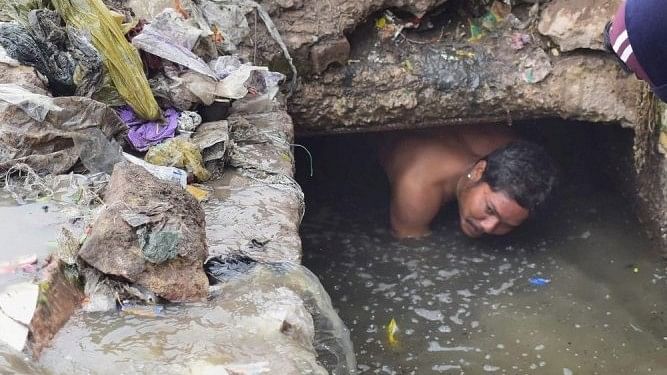
Representative image of manual scavenging.
Credit: PTI Photo
Prime Minister Modi’s participation in the Madiga Rally during the election campaign in Telangana strengthened the movement for sub-categorization among Scheduled Castes.
Historically, Madigas (Chamar) across the country were subjected to subordination and forced to engage in menial occupations to serve the dominant communities. They are also termed the most marginalised among the marginalised communities. While India celebrates its 77 years of independence, there still exists a section of society that has been treated as the lowest layer of the Indian caste hierarchy. Being born into the lower caste, Madigas are barred from adopting other occupations, which has made manual scavenging a traditional occupation, whereas the Mala (Mahar) community is mostly associated with agricultural labour. Madigas in India are often subjected to social exclusion and violence based on their caste identity; however, manual scavenging is regarded as the “menial job,” and what’s surprising is how the occupation is linked with the concept of purity and impurity in modern India.
Several organisations and movements, such as Madiga Dandora, Safai Karmachari Andolan, and several others, are fighting for dignity, equality, and justice for lower castes. According to Safai Karmachari Andolan, there are 26,00,000 people involved in community dry latrines, 7,70,000 workers in sewer cleaning, 36,176 manual scavenging at railway stations, and nearly 1,760 individuals have lost their lives due to poisonous gases while clearing the clogs. Manual scavenging was abolished through the Employment of Manual Scavengers and Construction of Dry Latrines (Prohibition) Act of 1993, which was again altered by a stronger law, the Prohibition of Employment as Manual Scavengers and Their Rehabilitation Act, according to which manual cleaning was allowed with precautionary measures only in places where machines cannot be deployed.
PM Modi’s government introduced programmes such as Swachh Bharat Abhiyaan and the National Action for Mechanised Sanitation Ecosystem (NAMASTE) to promote mechanisation by protecting and training workers. However, these schemes are not fully involved and are left half-implemented, as they have been continued for years and have not been fully abolished. Modi, in his book “KARMAYOG,” referred to manual scavenging as a “spiritual experience,” but later he changed his stance to abolish manual scavenging in one of the Mann Ki Baat episodes on the 125th birth anniversary of Babasaheb Ambedkar. Appreciation and encouragement for manual scavenging will increase caste discrimination and the exclusion of marginal communities. While the PM promised to end the practice of manual scavenging, his jumlas have never turned into reality because what has been promised during election campaigns is never fulfilled. It was not necessary to create an emotional moment by washing the feet of the sanitation workers in Prayagraj; fulfilling their rights and bringing them justice to live a life of dignity and freedom from dehumanising work is more important than political interests.
India has achieved technological advancements in the medical sector and has successfully reached the moon; the eradication of manual scavenging is not very impossible. The three-dimensional approach can solve the scavenging community issues in India permanently. First, the social stigma attached to casteism and traditional occupations should be addressed with legal measures. For instance, ragging was one of the major concerns in higher educational institutions across the country, which led to dropouts and suicides. After adopting stringent anti-ragging laws and legislation, ragging was completely eradicated from universities and colleges.
The second is the implementation of sub-caste reservations. The sub-castes among Dalits were treated as others within the community. They were subjected to intra-exclusion and discrimination. The implementation of reservations within reservations will give access to education and employment. The sub-categorization will lead to the economic and political empowerment of the scavenging community. The third is the use of technology in hygiene and cleaning. State and Union governments should invest in technology to clean public places, roads, and latrines. There are many options available to replace manual scavenging and reduce the death rate.
(Kumar is the Head, Dept. of International Relations, Peace, and Public Policy, St Joseph’s University, Bengaluru, and Sana Ahmed is a research scholar at NLSIU, Bengaluru)